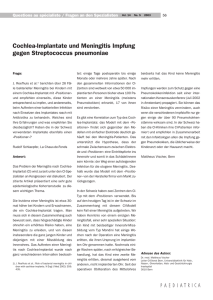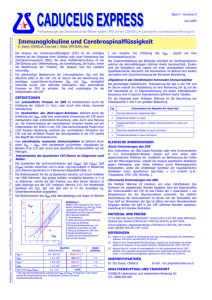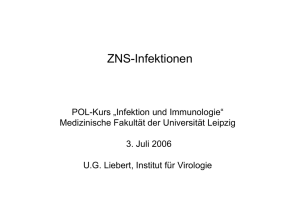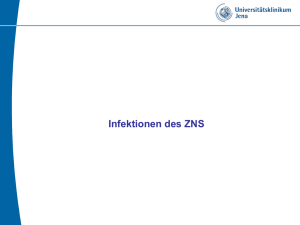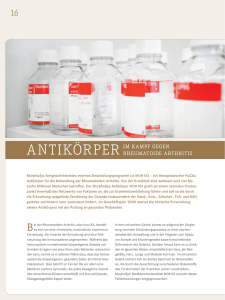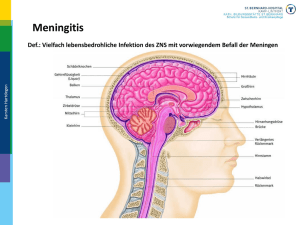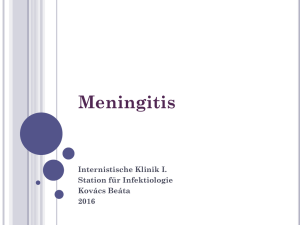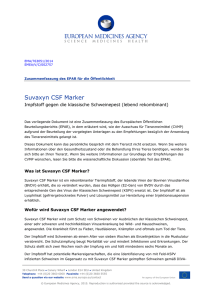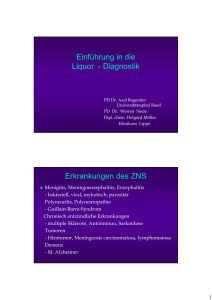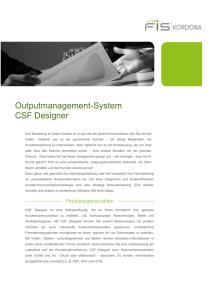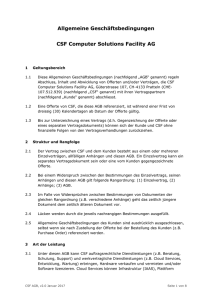Metalloproteinases in Viral Meningitis - ETH E
Werbung
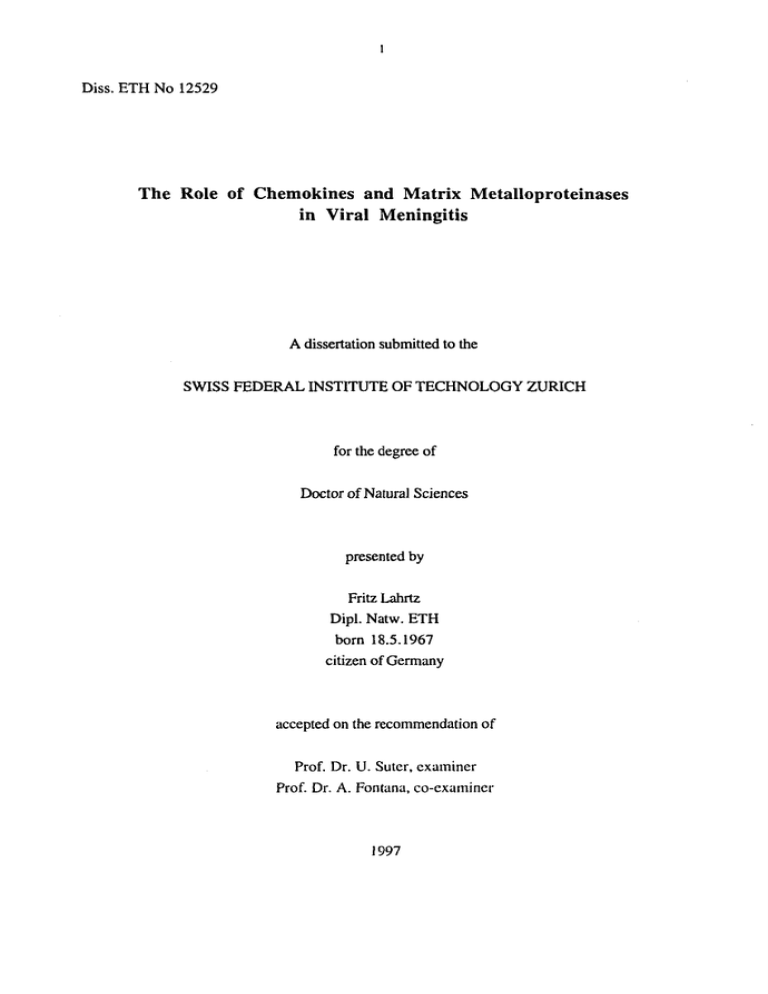
1 Diss. ETH No 12529 The Role of Chemokines and Matrix in Viral Metalloproteinases Meningitis A dissertation submitted to the SWISS FEDERAL INSTITUTE OF TECHNOLOGY ZÜRICH for the degree of Doctor of Natural Sciences presented by Fritz Lahrtz Dipl. Natw. ETH born 18.5.1967 Citizen of Germany accepted on the recommendation of Prof. Dr. U. Suter, cxaminer Prof. Dr. A. Fontana, co-examiner 1997 3 1. Zusammenfassung Die infektiöse Leukozyten und das von Zellen des finden sich auch Ventrikelsystem Immunsystems fliesst Um besteht Bei viraler Meningitis T-Lymphozyten Die Chemokine, einer Chemokins zu im Liquorraum von gelangen, müssen der wandern, sofern sie Beginn Leukozyten vorwiegend Monozyten auf Rezeptor für und auch man Liquorsystem gebildete im des Lage sind, entlang den die der Krankheit findet kleinen löslichen Proteinen der in eingewanderten Endothelzellen und Basalmembran Leukozyten konnte der Leukozyten zu aus Laufe der Krankheit zu Die welcher durch den Subarachnoidalraum hauptsächlich Liquor gefunden, Untergruppe zurückzuführen sein, da die werden Einwanderung Neutrophile eines im den in hervorgerufene charakterisiert durch ist diese Gewebe in Liquor cerebrospinalis, im Blut-Liquorschranke überwinden, aktivierte durch Bakterien oder Viren vorwiegend ist eine Meningen und des Plexus choroideus Die Krankheit Einwanderung eine die Meningitis der Entzündung großen Zytokinfamihe, Konzentrationsgradienten dieses Chemokin auf ihrer Zelloberflache exprimieren Das Ziel dieser Doktorarbeit war, die Rolle der Chemokine bei der Liquorraum den Konzentration Fähigkeit an bei viraler Chemokinen Meningitis in den Liquores untersucht, der Leukozyten auszulosen untersuchen zu Liquores von vitro in Chemokine für die chemotaktische Aktivität der Im Liquor von Patienten mit viraler Liquores gefundenen Subtypen wurde IL-8 als für die da die Konzentration korrelierte und an Liquores bakterieller von Bei reduzierten Meningitis Die chemotaktisch aktiv für Meningitis dei in Multiplen ist den Sklerose von in die von vorhandenen spezifisch wichtig die nachgewiesen werden in den auch waren in Liquores vitro in den Dabei identifiziert, der Patienten von chemotaktisch Liquor für aktiv für für die chemotaktische Aktivität für waren für die chemotaktische Aktivität von denen bekannt ist, daß sie bei Liquor gefundenen Leukozyten sind, konnten interessanterweise nicht Liquorraum der Ort der im Subtypen entscheidendes Chemokin Neutrophilen Liquores war Zellen einen verantwortlich sind Andere Chemokine, bei dieser Krankheit selektive Rolle Immunzellen kiankhcit, an von zum Liquor im konnten Chemokine, die Neutrophilen MCP-1 für aktivierte T-Zellen bei Patienten mit viraler eine Liquores wahrend MCP-1 und IP-10 entscheidend Monozyten, verschiedener gegen IL-8 die chemotaktische Aktivität und aktivierte T-Zellen Monozyten von IL-8 mit der Anzahl Antikörper Migration werden, daß die Immunzellen anziehen können, Einwanderung Neutrophile signifikant der an Meningitis wurde Patienten bestimmt Zum anderen wurde die eine Es konnte dann gezeigt Einwanderung Dazu gefunden werden Dies deutet auf IL-8, MCP-I und IP-10 bei der Einwanderung hin (MS), Entzündung einer dcmyehnisierenden, entzündlichen die weiße Substanz in Hirn und Autoimmun- Ruckenmaik, deren 4 wahrend der Krankheit durch Myelinscheide gegen es uns feststellen Da Hirnparenchym wie Schädigungen Entzündung Die eine im der teilweise angrenzt, ein zu locken, welcher Meningitis, Liquor der konnten der eine zur bei der viralen Bedeutung der MMPs bei viraler Doktorarbeit die Konzentrationen bestimmt Es konnte ein 1, MMP-2 und MMP-8 an TIMP-1, einem Zusammengefaßt Chemokine beteiligt wie sind durch Pathogenese waren Parenchym Meningits an von ist die MS Expression von MS das MMPs eine zu in Chemokinen anderer im Liquor oder sein bei viraler Meningitis schließt Blutgefäße Entzundungs-krankeiten publizierte spielen von im Um die war mögliche dritten Teil dieser Patienten mit viraler Spiegel festgestellt werden, nicht erhöht Interessanterweise auch bei der Invasion konnten untersuchen, wurden Liquores und nicht, Hirnparenchym die Endothelzellschicht der Rolle Ort der zum Der Grund für das Auftreten einiger Leukozyten an zu erhöhten keine Leukozyten spezifisch im Daher MS Patienten von mit Metalloproteinasen (MMPs) Meningitis erhöhter MMP-9 Liquor Bereich der zellularen Infiltrate der Basalmembran, die In der letzten Zeit Leukozyten Fall im im lokal erhöhte Chemokinkonzentation Arbeiten lassen den Schluß zu, daß Matrix von Gruppen Liquorraum Blut-Liquorschranke Zerstörung Antikörper das ZNS werden Immunzellen auch Patienten von verschiedenen Blut-Liquorschranke im Überwindung Chemokinen Liquor im von an beschrieben wurde, scheinen Chemokine bei der infektiösen weniger Zellen jedoch konnten und bedeutend geringerer Anzahl als bei viraler Meningitis in interessant, die Konzentration Chemokinspiegel Infektion oder auch wenn Wir bestimmen im Leukozyten Entzündung typischerweise paraventnkular abspielt, Liquor gefunden, schien und zerstört wird Dabei infiltrieren Myelin angegriffen Da sich die Lymphozyten, Makrophagen andere MMPs Meningitis wie MMP- ebenfalls die Konzentration Protein, daß die MMP-9 Aktivität reguliert, erhöht weisen auch die in dieser Arbeit vorgestellten Ergebnisse Martnxmetalloproteinasen am darauf hin, daß sowohl Krankheitsverlauf der viralen Meningitis 5 2. Summary Infectious meningitis mainly provoqued by bactena meninges and the choroid plexus Thereby, system Inflammatory leukocytes are also found the in cells have to pass the blood-CSF-barner consisting membrane In viral meningitis compartment Neutrophils endothelial and of small The aim by cells of the Dunng mainly of observed in are able to migrate receptors for the chemokines of this thesis was to along on lymphocytes invade the CSF of the disease Influx of the early stages the CSF in or System (CNS) the surroundmg Chemokines immune system their surface in the viral meningitis Chemokine levels invasion in inflammatory of the CSF of the patients measured, and chemotactic activity of CSF for different leukocyte Subtypes determined This chemotactic activity was are a gradient of chemokines lf they the concentration investigate the role of chemokines compartment in flows the process of invasion, the endothelial cells and the basal monocytes and activated T the CSF at immune (CSF), which fluid which show chemotactic activity for cells of the cytokmes cells into the CSF were lnflammation of the cerebrospinal cells of the Central Nervous parenchymal Leukocytes express the an guided by the expression of selective chemokines cells may be because are mainly is invaded viruses are the subarachnoid space and the ventricular system through family and these tissues then correlated to the of chemokines occurence was in the in the CSF Chemokines CSF of patients with viral meningitis contnbutor to the of active for the different chemotactically neutrophils invasion found of were neutrophils, detected as of inflammatory the CSF in IL-8 levels IL-8 neutrophils monocytes and activated T cells MCP-1 identified was was other chemokines known types of leukocytes found in in CSF vitro in In in the inflammation multiple sclerosis, inflammation nerve fibers a in also were significantly chemotactically on on activated T cells bactenal meningits to be chemotactic active for the the CSF of the patients not identified were a in the majonty of the selective role of IL-8, MCP-1 and viral meningitis demyehnating inflammatory is the white matter of brain and is attacked spinal cord by lymphocytes, macrophages myelin Leukocytes, mainly major important for the chemotactic activity CSF from patients with viral meningitis, which points to IP-10 as a the CSF correlated with the number in monocytes, while MCP-1 and IP-10 together mediated chemotactic activity Interestingly, cells found the CSF of the patients and antibodies against IL-8 in inhibited chemotactic activity of the CSF for active for Subtypes autoimmune Dunng and disease, MS the autoreactive activated T cells, invade the brain the myelin place antibodies parenchyma MS of sheet of the is against mainly a 6 paraventncular disease, therefore, inflammatory leukocytes sigmficant lesser extent than chemokine levels in viral meningitis in the CSF of elevated chemokine concentrations point Though patients with MS, were detectable to an expression of chemokines in the brain attract leukocytes specifically the brain parenchyma presence of a the to place in leukocytes elevated chemokine concentrations in too the in interesting for CSF, but us to a to measure In contrast to viral meningitis, no these CSF As data from different groups or chemokines inflammation, which viral meningitis is, seem in case The to of MS, reason for the the CSF of MS patients may be either locally damages or also found parenchyma dunng MS, of infection and not the CSF compartment small number of are lt was as in of the blood-CSF-barrier at the place of the cellular Infiltrates Passing the blood-CSF-barrier of the basal membrane previously about the (MMPs) may play meningitis, the a viral meningitis in underlying pathogenesis role in of other of MMPs determined Elevated levels of MMP-9 2 and MMP-8 regulates Taken were not induced MMP-9 activity, together, the work was metalloproteinases therefore to a better found also increased in understanding To Interestingly, presented and matnx in cells includes Based examine on a degradation the results matnx pubhshed metalloproteinases the involvement of MMPs in the CSF of patients with viral meningitis in were layer inflammatory diseases, viral meningitis concentrations by inflammatory the endothelial cell in in the CSF, other MMPs as the concentration of TIMP-1, viral were MMP-1, MMPa protein which the CSF this thesis points to the involvement of both chemokines the onset and progression of the pathogenesis of viral meningitis and of the disease leads
